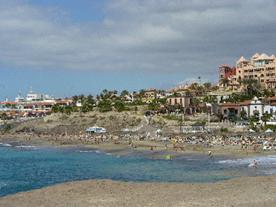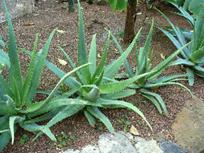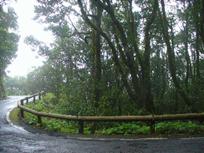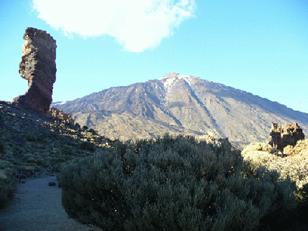 The Canary Islands consist of seven islands. In time of Homeros they were called the `islands of eternal spring`. Tenerife is the biggest one whose territory is 2034 sq.kms. Pico del Teide (3718m) is the highest summit of Tenerife as well as of the Canarian archipelago and Spain. The Canary Islands consist of seven islands. In time of Homeros they were called the `islands of eternal spring`. Tenerife is the biggest one whose territory is 2034 sq.kms. Pico del Teide (3718m) is the highest summit of Tenerife as well as of the Canarian archipelago and Spain.
There is a large range of entertainments, such as lying on the beach, sunbathing, spalshing it the ocean, going on a tour in the forest, walking in shopping centers, climbing the rocks of Teide, meeting orcas, here everything is possible.
Since the coast of the black continent is merely 300 kms away, many think the average temperature is similar to that of Africa. In fact this is not true because the prevailing season is rather spring which ensures a stable and pleasant temperature throughout the year meaning that in the summer the temperature hardly goes higher than 30 degrees, while in the winter season it rarely goes under 20 degrees.
 
The surface and the vegetation is remarkably variable. You can see vertical cliffs higher than 100 meters, lavaflowing, barren land like the suface of the Moon, halfdesert areas with vegetation resistant t o dry conditions, tropical and subtropical plants and depending on the hight leafy and pines. It is interesting to observe the diversity of the land from the shore: you can see palm trees on the seaside, cactuses on the lower hillside, leafy forest at the hight of the clouds, pine-forest above it, and finally on the top desolate and snow-coverded peak. On Tenerife there are approximately 140 unique plants which can only be found here. o dry conditions, tropical and subtropical plants and depending on the hight leafy and pines. It is interesting to observe the diversity of the land from the shore: you can see palm trees on the seaside, cactuses on the lower hillside, leafy forest at the hight of the clouds, pine-forest above it, and finally on the top desolate and snow-coverded peak. On Tenerife there are approximately 140 unique plants which can only be found here.
 One of the main spectacles of the island is the magnificent and unapproachable Teide. It can be seen from a great distance, and it shows the way towards the island. It often slips into clouds. Up there it looks like as if you were on the Moon and it has not lost anything from its charm. There was an eruption in 1909 on the northern slope. Teide is also called as a weather-dividing line: it divides the island into two different climate areas. The humid air of the northwest region is caused by the heat of the crater and it nourishes rich tropical vegetation and evergreen grapevines, whereas the the hot south part is rocky and dry. Therefore, Tenerife is often called a miniature continent. One of the main spectacles of the island is the magnificent and unapproachable Teide. It can be seen from a great distance, and it shows the way towards the island. It often slips into clouds. Up there it looks like as if you were on the Moon and it has not lost anything from its charm. There was an eruption in 1909 on the northern slope. Teide is also called as a weather-dividing line: it divides the island into two different climate areas. The humid air of the northwest region is caused by the heat of the crater and it nourishes rich tropical vegetation and evergreen grapevines, whereas the the hot south part is rocky and dry. Therefore, Tenerife is often called a miniature continent.
The rocky, volcanic ground and the solidified lavaflowings of the National Park give us a great opportunity to marvellous hikes. The Teleférico, in other words the cable railway, takes you up as high as 3550 meters, to the station of La Rambleta. From there you can go around but the peak can be visited only with special permission issued by Ministerio de Medio Ambiente.
Rumour has it that the island was named after the canary bird however the island gave its name to the bird and not inversely. The word canary comes from Latin canis (dog), after the large breed dogs found on the island. The original name of canary bird is Teide-bird, as it used to live only in the high mountains of Tenerife. |

 The Canary Islands consist of seven islands. In time of Homeros they were called the `islands of eternal spring`. Tenerife is the biggest one whose territory is 2034 sq.kms. Pico del Teide (3718m) is the highest summit of Tenerife as well as of the Canarian archipelago and Spain.
The Canary Islands consist of seven islands. In time of Homeros they were called the `islands of eternal spring`. Tenerife is the biggest one whose territory is 2034 sq.kms. Pico del Teide (3718m) is the highest summit of Tenerife as well as of the Canarian archipelago and Spain.


 o dry conditions, tropical and subtropical plants and depending on the hight leafy and pines. It is interesting to observe the diversity of the land from the shore: you can see palm trees on the seaside, cactuses on the lower hillside, leafy forest at the hight of the clouds, pine-forest above it, and finally on the top desolate and snow-coverded peak. On Tenerife there are approximately 140 unique plants which can only be found here.
o dry conditions, tropical and subtropical plants and depending on the hight leafy and pines. It is interesting to observe the diversity of the land from the shore: you can see palm trees on the seaside, cactuses on the lower hillside, leafy forest at the hight of the clouds, pine-forest above it, and finally on the top desolate and snow-coverded peak. On Tenerife there are approximately 140 unique plants which can only be found here. One of the main spectacles of the island is the magnificent and unapproachable Teide. It can be seen from a great distance, and it shows the way towards the island. It often slips into clouds. Up there it looks like as if you were on the Moon and it has not lost anything from its charm. There was an eruption in 1909 on the northern slope. Teide is also called as a weather-dividing line: it divides the island into two different climate areas. The humid air of the northwest region is caused by the heat of the crater and it nourishes rich tropical vegetation and evergreen grapevines, whereas the the hot south part is rocky and dry. Therefore, Tenerife is often called a miniature continent.
One of the main spectacles of the island is the magnificent and unapproachable Teide. It can be seen from a great distance, and it shows the way towards the island. It often slips into clouds. Up there it looks like as if you were on the Moon and it has not lost anything from its charm. There was an eruption in 1909 on the northern slope. Teide is also called as a weather-dividing line: it divides the island into two different climate areas. The humid air of the northwest region is caused by the heat of the crater and it nourishes rich tropical vegetation and evergreen grapevines, whereas the the hot south part is rocky and dry. Therefore, Tenerife is often called a miniature continent.